The story of honey is as old as some of the oldest stories we know.
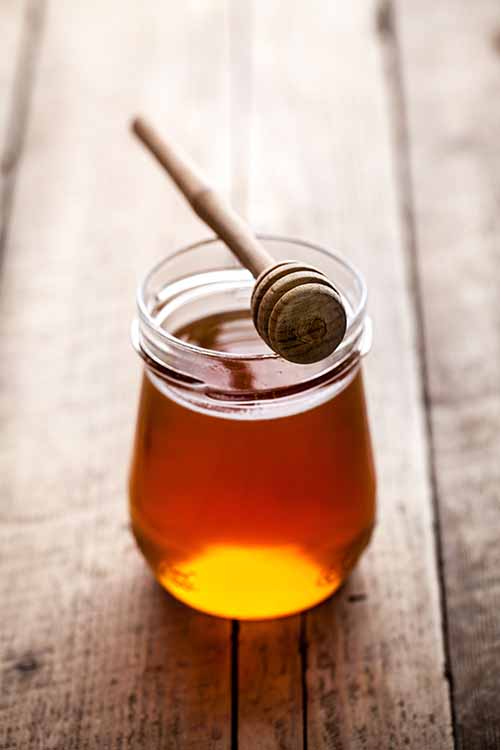
The Bible describes a land where milk and honey flow. A prosperous land, well equipped with everything one could ask for.
Nowadays, lots of different sorts are available, and each one has specific unique characteristics. They all differ in flavor, color, intensity, and texture.
Yet, they all share the same mode of production: bees that collect pollen and nectar from flowers produce honey.
It is a truly natural product that has always been popular – not only as food, but also as a medicinal product.
One type in particular, Manuka, has become a well-known representative of healing honeys. In this article, we’ll also take a look at this very special type and its particular qualities.
Varieties of This Sweet Golden Goo
The various sorts basically differ in origin (flower nectar or sometimes a sweet product known as honeydew, which I’ll cover in more detail later), color, and flavor.
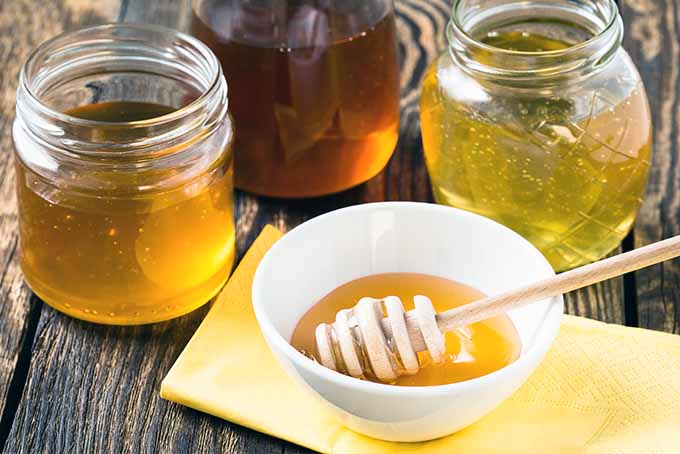
However, all kinds share the same general ingredients. They consist of approximately 80 percent sugar (glucose and fructose in varying relations), plus natural substances from the different kinds of nectar, which are responsible for variations in color and flavor.
There are liquid and firm varieties available. The consistency depends on the content of glucose and fructose, and the way in which the honey is processed through filtration, mixing, the addition of heat, and so on.
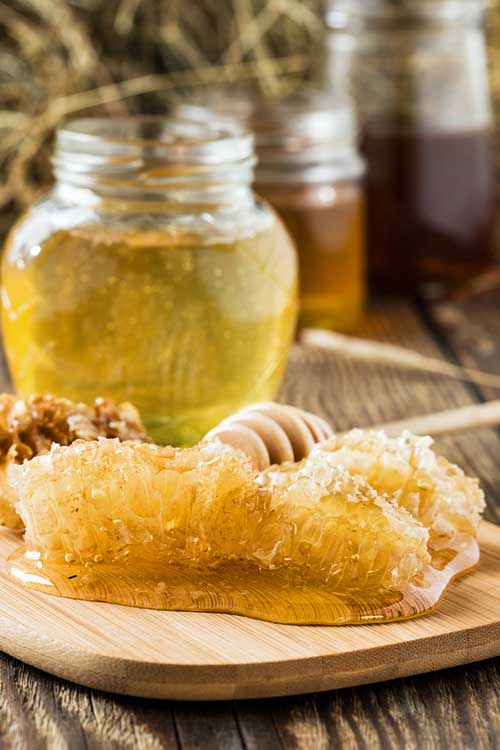
A higher amount of glucose leads to quicker crystallization, meaning it becomes firm and opaque with time.This is not a sign of good or bad quality, simply a matter of preference. Firm, crystallized honey can be warmed up to become liquid again, too.
The three basic categories of honey are:
1. Single origin
Nectar mainly comes from one specific plant –such as clover, for example.
2. Multi-flower
Nectar that the bees collect comes from different plants. The resulting varieties can vary a lot in flavor and appearance, such as wildflower types.
3. Local
Nectar is collected from a specific region or territory, such as a special mountain area or the California coastline.
A Note of Caution:
Always be sure not to feed any honey to babies and toddlers less than 3 years old, or immune compromised individuals. Because it is a raw, natural product, it can contain bacteria that small children and immune compromised people can’t process.
Now, let’s take a look at how the origin influences the colors and flavors of the different types.
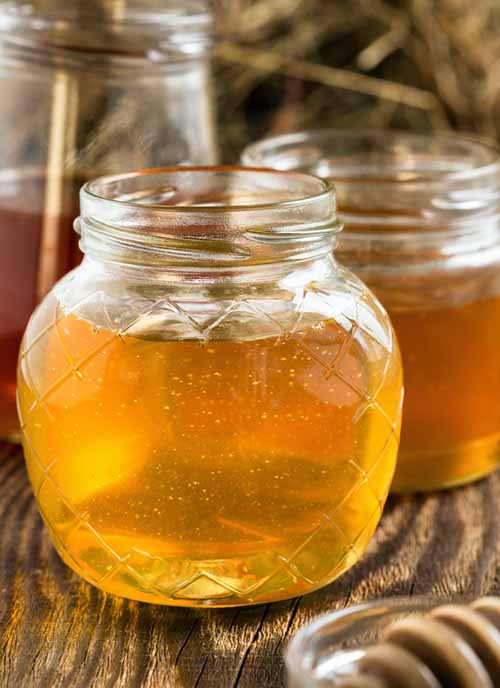
Dark Types
In general, the darker sorts have a stronger and more distinctive aroma. They not only taste less sweet, but they are typically rather tangy with a bitter, malty note.
Varieties like avocado and buckwheat are a few of the more popular representatives.
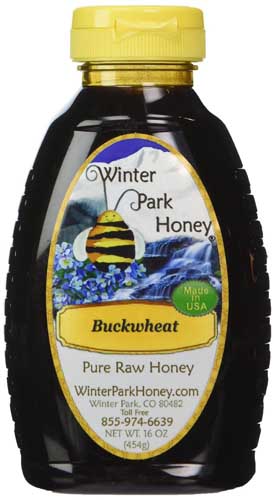
Raw Buckwheat Honey, available on Amazon
Forest, fir, or pine honey are a few additional dark varieties.
In areas where flower nectar is not available, bees will sometimes collect honeydew, the sugary metabolic product (or secretions) of specific scale insects that live on plants, or even invasive spotted lanternflies. This can be found on the pine needles or leaves of trees. In some areas, products of this type cannot legally be classified as honey.
Light Types
Varieties that are lighter in color usually have a mild, floral flavor, and a color that ranges from nearly clear to white, pale yellow, golden, orange, or red.
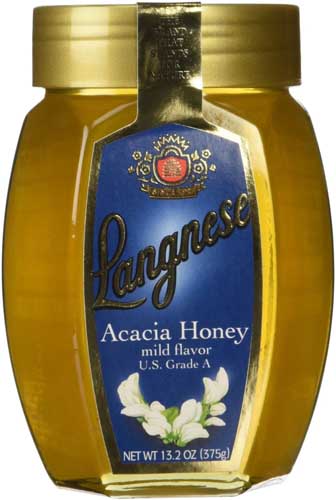
Acacia Honey available on Amazon
These include clover and acacia, as well as many wildflower varieties. The bees find the required nectar in the blossoms.
Depending on how the nectar is collected, you will find single origin and multi-flower varieties in this group.
Here, you’ll find an overview of some of the most common sorts:
| Consistency | Color | Flavor | |
|---|---|---|---|
| Acacia | fluid | golden yellow | mild, floral notes |
| Alfalfa | moderately thick | yellow to amber | less sweet than other varieties, spicy nuances |
| Avocado | silky, smooth, rich | dark amber | complex with warm, toasty notes |
| Buckwheat | thick, rich | dark, ebony colored | malty, spicy, intense |
| Blueberry | smooth, buttery | amber | toasty with herbal notes |
| Chestnut | gooey, thick | amber to very dark brown | malty and herbal, less sweet than other varieties |
| Clover | crystallizes quickly, spreadable, smooth | white to pale yellow or amber | floral and mild |
| Eucalyptus | thick, rich | light to dark amber | herbal nuances with cool and complex flavor |
| Forest | gooey, rarely crystallizes | amber to dark brown | less sweet than other varieties, spicy and intense aroma |
| Orange Blossom | smooth, creamy | light to medium dark | fruity, mild floral notes |
| Sage | smooth, rarely crystallizes | light amber | delicate, fruity to herbal nuances, less sweet than other varieties |
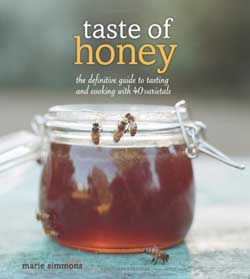 Some of the information found in this table (and elsewhere in this post) was sourced from “Taste of Honey: The Definitive Guide to Tasting and Cooking with 40 Varietals” by Marie Simmons, available on Amazon. It’s a great read, especially if you’re interested in learning more about adding various types of honey to your culinary repertoire.
Some of the information found in this table (and elsewhere in this post) was sourced from “Taste of Honey: The Definitive Guide to Tasting and Cooking with 40 Varietals” by Marie Simmons, available on Amazon. It’s a great read, especially if you’re interested in learning more about adding various types of honey to your culinary repertoire.
Liquid, Whipped, and Honeycomb
Besides dark and light types, you can also differentiate between production processes. Most of what you will find available for sale belongs to the liquid nectar group, wherein the honeycombs are spun in a centrifuge to retain the actual product.
This liquid type is available in two varieties: raw or cold packed, and pasteurized. While the raw version includes pollen and minerals (particularly if it has not been filtered) and is therefore very popular, pasteurized sorts offer their own advantages, and they do not crystallize so quickly. But as crystallization is a natural process, this is more a matter of personal preference.
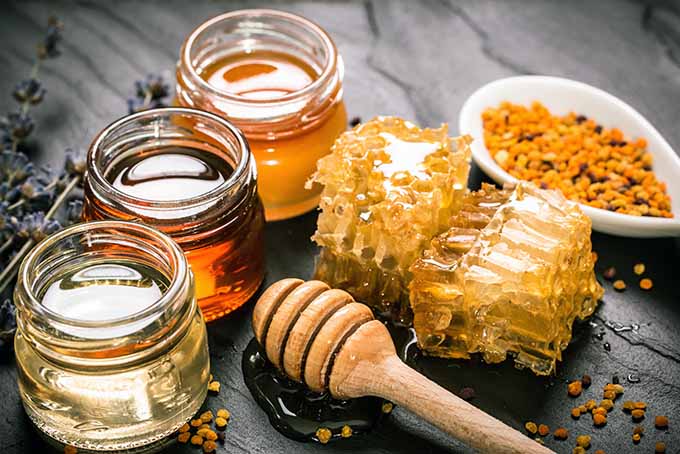
Also, it’s important to keep in mind that most types do tend to crystallize over a certain time period anyway.
Pasteurization of honey is like the process done to make dairy products safer for human consumption, but it is not used for the same reason.
Since honey is high in acid with a low moisture content, it doesn’t provide a nice environment for potentially harmful bacteria to thrive. Some types of yeast can sometimes survive, so pasteurization kills these, but as I mentioned above, it mostly just helps to prevent crystallization.
The whipped variety provides a special texture, too. This type of processing is used when the honey already contains sugar crystals. By whipping in air, it will keep its smooth and spreadable texture over a longer period.
Comb honey is a true specialty, because it is sold in its original wax reservoirs, cut into pieces. This not only looks great, but it also offers you a direct connection with and experience of the natural product. Sometimes, you can find fluid sorts that contain individual pieces of honeycomb, too.
A Natural Sweetener for Lots of Recipes
Honey is not only a delightfully sweet spread to put on toast, it can also be used in drinks, cakes, or sauces.
Why not substitute sugar with it in some baked goods? Considering that the natural product has a stronger sweetening power, you can reduce the amount of required granulated sugar. Approximately 1/3-1/2 cup of honey can replace 1 cup of sugar (1).
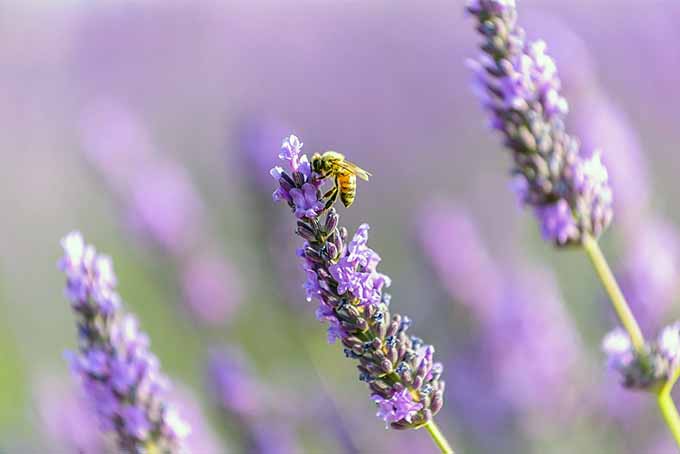
The only thing you have to keep in mind is that your cake, for example, might brown a bit faster than it would otherwise. So keep an eye on your goodies in the oven, and cover with aluminum foil if the surface is getting too dark. Plus, consider that it provides more moisture than sugar, so you might need to add a little less liquid than usual.
If you have a look at the chart above, you’ll see that the flavors offered by various types can differ a lot. Make use of these tasting notes when you make a variety of sweet and savory dishes like:
- Sauces, dressings, and vinaigrettes for salad
- Glazes and sauces for roast chicken, duck, fish, or beef
- Anything made with goat cheese, feta, or fresh cream cheese varieties
- Cakes, other types of baked goods, or desserts
- Warm or cold drinks like tea (especially a spiced chai), milk, smoothies, cocktails, or juices
Tips for Storing
Actually, honey is quite undemanding. Kept correctly, it could probably outlast most of us.
If you want this sweet gold to retain its color and consistency, keep it cool and in a dark place, away from direct sunlight. Since it attracts moisture, store it in a dry place, well-sealed in the containers or jars it is sold in.
Some varieties may crystallize or thicken, but this doesn’t mean they are not edible anymore. Due to its makeup, these things just happen. Most blossom honeys crystallize between 2-6 weeks of storage, while acacia typically stays fluid for up to 12 months.

Firm, creamy sorts should be stored at 50-53°F (10-12°C), thin and fluid varieties between 64-68°F (18-20°C).
Now, let’s take a closer look at one special sort that has become famous, due to its unique antibacterial properties. By consuming Manuka honey, you can combine your desire for something sweet with a potentially healing effect.
If this isn’t a practical coincidence, I don’t know what is!
What is Manuka, and What Makes it so Special?
This specific kind is made of the flower nectar of New Zealand’s Manuka shrub, a relative of the famous Australian tea tree.
It is amber-colored, with an intense spicy aroma and a slightly herbal nuance. Its texture is tenderly melting and creamy.
This sort has been researched by scientists to find out whether the natives of New Zealand, the Maori, are right about its excellent healing qualities. And indeed, compared to other varieties, they are outstanding.
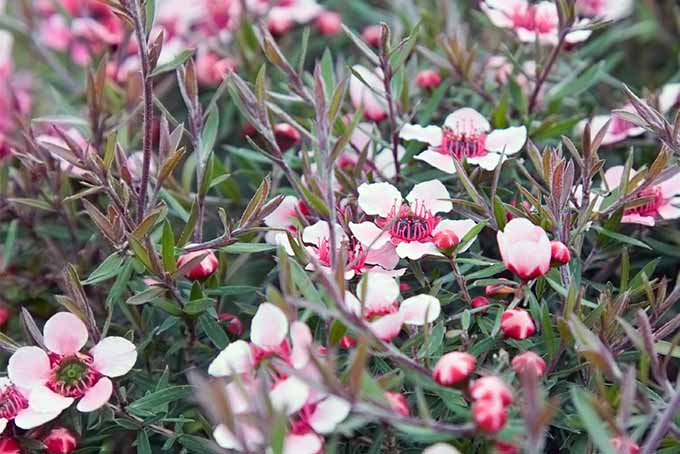
This has to do with one particular substance that Dr. Thomas Henle from the Institute of Food Chemistry at Dresden’s Technical University in Germany found in 2008.
The most important substance that could be identified through scientific study is methylglyoxal (MGO).
While most honey has an MGO content of one to two milligrams per kilogram, the research team found Manuka contains 300 to 700 milligrams per kilogram. A thesis written by Dr. Elvira Mavric would finally support the theory that MGO is directly connected to an antibacterial effect.
What conclusions could be drawn from this? Let’s take a look.
The Impact of MGO on Quality
To emphasize the specific nature of the Manuka type, we have to take a look at the content and significance of MGO.
As was described above, every sort of honey contains MGO – just not in such high quantities. Thanks to Dr. Mavric’s thesis, the following statement could be made: “A higher methylglyoxal level means that the antibacterial activity is higher, too.”
However, MGO levels can vary depending on the amount of time that the product has spent in storage, increasing over time. A lot of research still remains to be done to accurately determine the relevant health outcomes and effects.
According to this post from Healthy with Honey, though MGO is in fact a potentially toxic compound, it is also found in many foods and beverages like coffee and soy sauce. Though some experts claim it is safe for consumption at any level, more research is needed to prove this, and some recommend that high-quality Manuka is safe for external use only.
Not all Manuka honeys are alike, and it’s possible to find varieties with different levels of MGO. The MGO level indicates the antibacterial quality of the product. This rating is included on products that are bottled in Germany in particular.
But there is another way for you to find out about the quality. The UMF (Unique Manuka Factor) is an exclusive figure found on the label of Manuka products bottled in New Zealand. So, if you want to make sure you’re buying the real thing, keep an eye on the label, and see whether it includes one of the protected trademarks MGO or UMF. If so, you can feel certain that you are getting the genuine product.
If you find either value on a product label, here’s a chart to explain how they compare (2, 3):
| Minimum MGO | Manuka Honey Benefit | UMF |
|---|---|---|
| 30 | Insignificant levels of activity | - |
| 83-250 | Some levels of activity, used for general well-being | 5+ |
| 263 | High levels of activity, good antibacterial properties, used in prevention and for general well-being | 10+ |
| 354-400 | High levels of activity, good antibacterial properties, used in prevention and for general well-being, used for digestive healing and treating other ailments | 12+ |
| 514-550 | High levels of activity, good antibacterial properties, used in prevention and for general well-being, used for digestive healing and treating other ailments | 15+ |
| 692 | High levels of activity, good antibacterial properties, used in prevention and for general well-being, used for digestive healing and treating other ailments | 18+ |
| 829 | Superior levels of activity, very good antibacterial properties, used in topical applications | 20+ |
Possible Applications for Manuka
Of course, you don’t need to use the honey for its healing powers exclusively.
As this particular type is not as heat-sensitive as most of the others, it is the best choice to add to a mug of hot milk or tea, to enjoy the soothing warmth.
Nevertheless, its antiviral and antibiotic qualities indicate that it may be a great natural remedy to have on hand to soothe colds, coughs, or sore throats.
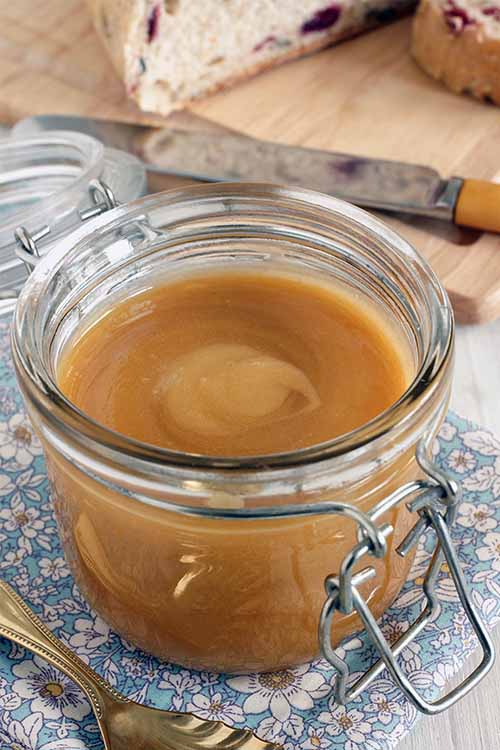
The easiest way to benefit from these potential healing properties when suffering from problems with one’s gums or oral cavity, coughs and sneezes, or sore throats, is to take a teaspoon of the sweet stuff and melt it in your mouth as slowly as possible. This should be done at least three times a day.
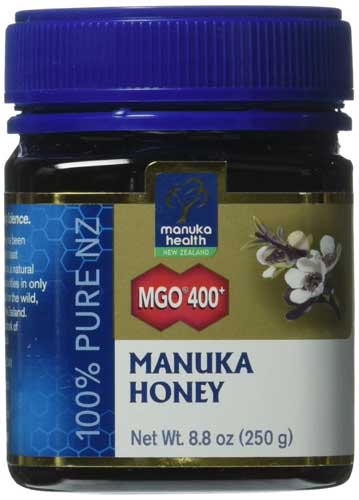
Manuka Health MGO – 100% Pure New Zealand Honey available on Amazon
And, for sure, don’t forget about all the fabulous things you would use regular types for – it’s great for those applications too! Might I suggest keeping it simple like Winnie the Pooh, and enjoy a paw of honey right from the jar?
Conclusion
Honey is a more varied product that one might think. Lots of different sorts can be found, all of which provide different flavors. Also, the consistency is not all alike, but depends instead on the sort of nectar that was used to produce it, as well as the methods used in processing.
If you store it correctly, you will be able to enjoy it for a long time and prepare amazing sweet and savory dishes. Or you may make use of the potentially beneficial qualities of New Zealand’s specialty honey as a natural remedy.
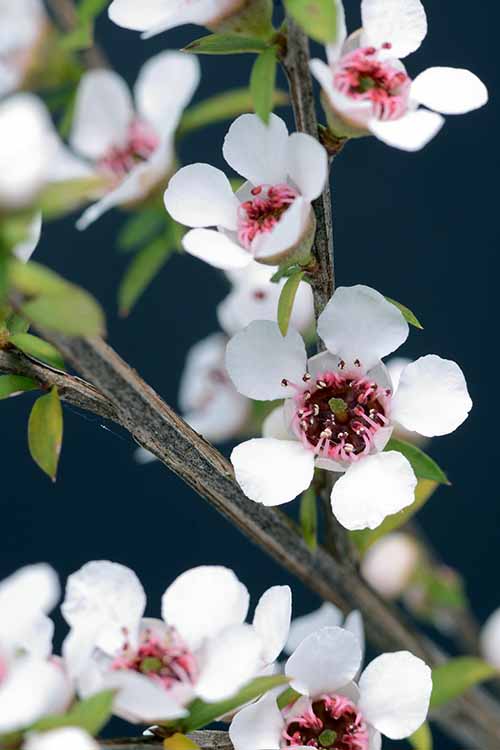
Were you already familiar with manuka? Or aren’t you a fan of the sweet and sticky syrup at all? Share your experiences, thoughts, and comments below!
For Further Reading
[the_ad id=”22921″]
Sources
1. Biesalski, Hans Konrad, Stephan C. Bischoff, and Christoph Puchstein.”Ernährungsmedizin: Nach dem Curriculum Ernährungsmedizin der Bundesärztekammer.” 4th edition, 2010, page 72.
2. “MGO Manuka Honey.”http://www.manukaonline.com/mgo-Manuka-Honey-benefits.html
3. Grey, Paul. “Manuka Honey MGO and UMF Ratings Compared.” 29 May 2014.https://export-x.com/2014/05/29/manuka-honey-mgo-umf-ratings-compared/
The staff at Foodal are not medical professionals and this article should not be construed as medical advice. Foodal and Ask the Experts, LLC assume no liability for the use or misuse of the material presented above. Always consult with a medical professional before changing your diet, or using supplements or manufactured or natural medications.
Photo credits: Shutterstock, Winter Park Honey, Langnese, Andrews McMeel Publishing, and Manuka Health.
About Nina-Kristin Isensee
Nina lives in Iserlohn, Germany and holds an MA in Art History (Medieval and Renaissance Studies). She is currently working as a freelance writer in various fields. She enjoys travel, photography, cooking, and baking. Nina tries to cook from scratch every day when she has the time and enjoys trying out new spices and ingredients, as well as surprising her family with new cake creations.



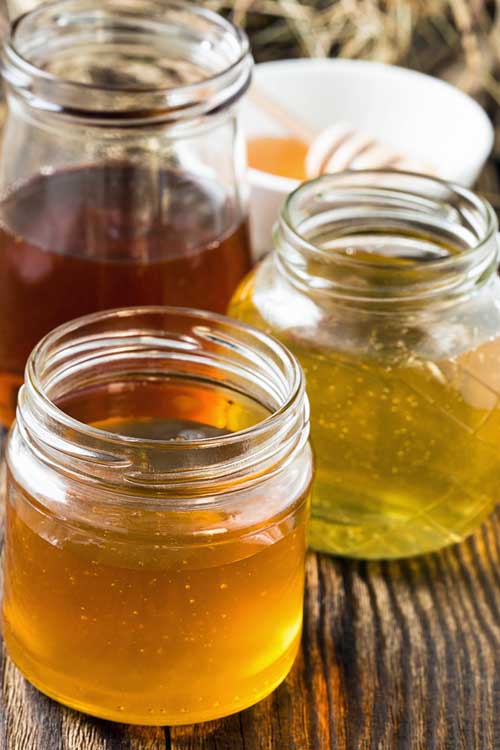



WOW, “sweet” content. Very useful and informative article Nina, much appreciated. I didn’t know there was so much to honey, wow.
Thank you! I’m happy I could provide some new information and you enjoyed reading the article.
Very informative post!
I particularly liked the part where you mention the effect glucose has.
Personally, I have quite a sweet tooth so honey usually plays a part in my diet. It was very interesting to learn how there are different kinds.
I always buy locally, I’m not sure why, it’s not cheaper but local foods always seem to taste better to me, the quality is better 🙂
I agree with you. When I have the chance to get local products, I prefer this. Right, it is not the cheapest option, but I also think that it provides a better feeling – and a better taste.
Keep on enjoying the sweet nectar 😉
I love these different uses of honey! I love it just on it’s own, drizzled over an english muffin or some fruit. I also love to add it to sweeten my morning smoothie! I’ve been having fun lately discovering the different varieties available from local beekeepers in our farmer’s markets. There are so many just in the area around my town it’s amazing!
Yummy, those are easy but definitely tasty choices! It sounds perfect having so many great options. You can always pick a new and interesting sort, enjoy the variety!
True
There were several varieties that I’m familiar with, but this article introduced me to some new ones too. I especially want to try the avocado out.
That one is an interesting sort, for sure. It is a bit rare around here, but when I can find it on markets or in wholefood stores, I make sure to get one. It’s always wonderful to try new – but also natural – flavors!
One thing i’m not so sure I want to try are the varieties made from bug secretions. That doesn’t sound so great to me, but to each his own, I guess. This article is very informative and I learned a lot, although I already knew about a few of the healing aspects of the stuff. It does make me want to try more recipes that include honey as an ingredient. I wonder where some of the more unique forms are sold at?
Thank you. That’s right, some sorts are difficult to find. I would love to give you some ideas, but I can mainly tell about the situation here in Germany. While some are available online, others can be found on farmers’ markets (great for local sorts) or maybe organic grocery stores. I hope you can find a good seller around.
Am planning to start my own apiary, though I don’t know how to start and the costs that I will incur.
I have also learned a lot, so informative.
Love the different recipes here, I will have to try some salad dressings! I use honey a lot in my smoothies, or just drizzled over fruit or an english muffin. YUM! Lately I’ve been having a lot of fun discovering local varieties at flea markets and farmers markets, it is amazing how many different beekeepers there are all around me making their own goodies!
Exactly, that’s the perfect way to discover various special sorts. I like the versatility of this golden syrup. Although it’s actually always the same product, it can have so many different qualities, flavors, etc.
My guilty pleasure is throwing a little into all sorts of dishes – sweet and savory. I come from this little district called Kodagu in southern India and it’s known for its forest honey. Despite that I had no idea that there were so many varieties, so many classifications. My mother briefly toyed with the idea of setting up a few bee hives but I think she’s given up that idea now! That Manuka variety looks amazing and I’ve never really heard of it before. Out here we also use a touch in several herbal remedies.
That sounds interesting. Varieties from forests are often very aromatic. I can imagine that is must have a unique flavor.
But using different kinds for savory dishes, too, works great, doesn’t it? Especially the ones that are less sweet can be added to many meals. It truly is an all-rounder!
I stopped using sugar for a lot of things I prepare nowadays. I drink tea and make my usual cakes and pastries with honey instead of sugar. It tastes much better!
It works nice as a substitute, right? I love the slightly note it provides for my madeleine sponge cookies, too. And due to the many variations, one can regularly experiment with sweetness and aroma!
I love how you have the table comparing the different varieties, its very informative! I had no idea that there was an avocado and blueberry sort, that’s pretty cool. I think that I will try substituting the sugar with honey in my baking, seeing that it is less than the sugar and it is much better for us health wise.
I typically use some for my sore throat and I also heard that it is good to have before a singing performance!
Thank you. I’m happy that my post included some new information for you. Replacing sugar with it works fine. I agree with you that it’s also more practical because you need less of it.
Using it as help for throat problems is something I like to do, too. Some warmed milk with a dash of honey is very relaxing, too, and an alternative to hot chocolate or tea in winter 🙂
I usually buy mine locally, a friend of mine is a beekeper and thanks to him, my pantry is always well stocked. Right now I have at least five jars with different varieties. I like the dark kind more than the light one, my favorites are the Chestnut and Eucalyptus varieties. I use it mostly on sauces or in hot beverages like tea or milk, my other half uses it on almost everything instead.
I had never heard about the Manuka honey, it sounds like something I could like, I love spicy and herbal nuances. Besides it sounds like it has many interesting properties. I don’t know if I’ll be able to find it in my city, but I will look for it. Otherwise I’ll buy it online. Thank you for the interesting informations!
Well, that’s awesome to have a beekeeper as a friend who can provide you with so many versions!
Chestnut and Eucalyptus are two special sorts, very intense – I think one can create some interesting recipes with those. Although – when I’m craving for some simpley honey on my toast – I prefer a light sort. But the great thing is that there is one kind to like for everyone 🙂
I hope you can find the Manuka variety and discover its wide-ranging qualities. If you prefer these flavors, I’m sure you’ll like this one, too!
There’s quite some worry about bees here in Europe due to the asian hornets population. They’re not indigenous and most species of bees here aren’t equipped to deal with them. Fortunately, communities mobilize quickly to deal with new nests – the things are huge and terrifying – but it’s still a issue.
I love baking with honey. Hopefully you’ll post some recipes to use these varieties with, as well. As usual with this blog, now I’m hungry!
Right, there have been many news on the problems of bees. I also think that it’s still something that needs to be discussed. Here in Germany, “urban gardening” has become a trend. People in cities plant flowers and/herbs that attract insects like bees etc. and try to provide new habitat to them. I like this idea and it might only be a start, but at least, people become aware of the problem!
While you can already find my madeleine recipe that is made with honey, you’re right that I could think about adding recipes with some of the special varieties. I will think about some nice ideas with those!
This is a great post. My grandmother really enjoyed putting honey is everything. I don’t like it as much as she did but it still is healthier for you then using sugar all the time. My boyfriend told me that it has a shelf life of over 3,000 years and it never expires. Does anyone know how true that really is?
That’s right, if it’s possible to replace it, this is always a nice way to go. Concerning the shelf life, I once have read that scientists (or rather Egyptologists) found some honey in an Egyptian grave which was that old. They said it would have been still edible – I haven’t done my own research on how trustworthy this it, but I suppose the sweet nectar can indeed keep fresh for a real long time.
I love the creamy type best because I love to eat them with freshly baked bread and without butter. I find that the clear types of honey crystallize on the bread. There’s something magical about the way this nectar is produced – I suppose it goes back to childhood and stories about the honey bees. But it is as fascinating to adults as to children – and the proof is in the crowds, of all ages, who gather around the stalls of the local producers at the twice-weekly market. They bring small, perspex-sided beehives with them and to watch the industrious bees is such a joy.
What a great idea to bring the busy bees and all the effort they put into their work closer to the people, I like that 🙂 I agree with you about the fascination, too. It’s really interesting to get to know details about the production – and also about the organization of bee colonies, with their complexity and hierarchy.. – and that all this leads to our tasty, sweet spread!
Thank you so much for this article, Nina! 🙂
I used to strongly dislike honey as a child, but lately I find myself incorporating more and more of it into my daily life. For example, I find that adding a half spoon of it into my morning coffee adds the same amount of sweetness as two spoonfuls of white nasty sugar 🙂
Question, what is your take on treating acne with honey? I know some people apply it on their faces as a mask but I’m a little hesitant to do so…
P.S
Definitely getting me some of that Manuka product.
Thank you, I’m happy that this was of interest to you. I can imagine that a dash of honey is a nice addition to coffee. Especially with all the different sorts, one can give it a new nuance from time to time, too!
Unfortunately, I have to tell you that I have no experience with treating acne. I have heard that honey is sometimes an ingredient of facial masks, but I can’t give you any medical advice on this.
So, that’s why honey colors differ from each other! I always thought that the dark ones are fake (just plain sugar syrup) while the light ones were real honey with water added to it. Haha 🙂 Well, at least I won’t prejudice against them anymore 😛
I’m sure there even might be some fake-products between the real sorts. When I look into the shelves in my grocery store, I also find lots of gooey, sugary syrups that look like honey (and are sorted nearby), but they aren’t. Indeed, one has to take a close look every time.
But now you know about their different qualities 🙂
Concerning your comment below, Manuka is the single variety whose medical qualities could be proven scientifically. I haven’t heard of other sorts. Are you able to order online? There, you will definitely find some high-quality products, or you may ask around and see if anyone can order it for you. I’ll keep my fingers crossed for you
Oh, and just a thought, other than Manuka honey, what other type of honey are medicinal? Because I don’t think Manuka honey is sold in my country 🙁 🙂
Very informative. Honey really has tremendous healing power. It’s really good for coughs and cold and it helps keep the body warm in the winter. It is said that daily consumption of honey along with garlic keeps the heart healthy forever. Bu, I never knew about so many varieties of it and I am particularly fond of the greasy jelly type honey and as a child used to have pure honey obtained directly from the beehive which was available in our small township. Would love to taste the different types mentioned here.
Thanks. You’re right, isn’t it fantastic to have a natural product with all these useful qualities? It seems like honey can’t be anymore optimized 😉 I hope that you can find some of the specific varieties where you live, it’s really interesting to taste the differences between some of the sorts.
But, having the possibility to obtain the sweet nectar directly from the busy bees, like you say, is probably the best things possible 🙂
Thank you for sharing, as a health professional, I try to use honey for sweetening than all this white refined sugar that has nothing in it apart for empty calories.
This is an extremely interesting article, I had no idea about the varieties of honey, it’s always good to know those facts :).
My mom a few years ago used honey as a substitute of sugar and she still does, she often says that honey gives a natural taste to the food in comparison to sugar, and it’s actually more healthy without mentioning all the properties that it has.
Thanks for sharing!
Thank you, I’m happy that my article was helpful 🙂
I think it’s a good thing to replace sugar with this natural sweetener whenever possible. I really enjoy the nice subtle and floral flavor.
Hope you enjoy using it for several recipes, and maybe you’ll find some of the interesting sorts where you live, too 🙂
Well I must be honest I really had no idea there were so many varieties of honey out there. I cannot really say that I surprised, but it makes me wonder what my local store is doing not having anything besides just the regular. Anyways, I really would like to try the avocado honey, and I love avocados in all forms but I think I would still be a little nervous, but I am sure it would be delicious. Thank you for sharing.
What a pity, maybe you can find some interesting variety online. I am quite lucky that an organic store nearby sells lots of different sorts, so one can always try something new. The avocado one is really worth to look out for, kind of a new approach to this delicious fruit. 🙂 Interesting and unusual!
Wow, this is quite informative! I did know honey had a TON of great health benefits, but I didnt know there were so many types of honey. I always just thought there was “real honey” and “processed fake honey”. I will take a closer look when I visit the grocery store next.
Nice piece of information. Indeed very useful and educating information.
My question is, do ants naturally feed on honey? Because some said it’s a sign of adulterated honey. Thank you.
This is a common myth. Pure honey does in fact attract ants, particularly in humid conditions.